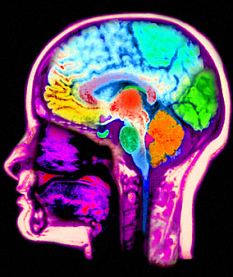
科学家们开发新方法治疗脑肿瘤(图)
来自维吉尼亚共和国大学医学院和技术中心的科学家们声称,他们研发了一种新型分子可用于脑肿瘤的成像及治疗。
成胶质细胞瘤是人类中最常见和危险的脑肿瘤,其发生恶化的几率极高。这些肿瘤细胞通常扩散很快且分布的边缘界限不清,因此在临床上非常难以进行成像和放疗。最近,科学家们开发了一种新的方法,它能够有效的攻击这些细胞来延缓或阻止它们的恶化。
在最新一期的《Radiology》杂志上,维吉尼亚共和国大学医学院放射物理学和生物学专家Panos Fatouros教授及它的研究小组们宣称,在动物身上,通过一个含有核磁共振成像(MRI)诊断剂的纳米级颗粒可以有效的对这些脑肿瘤进行成像和放射治疗。
这个纳米颗粒中含有钆、非常灵敏的用于成像的MRI造影剂和用于短程治疗的放射性镥177。通过一个简单的混合可以使它能同时有效的进行治疗和成像。
Fatouros实验室的Michael Shultz博士说道:“这个纳米级的复合物能稳定的停留在肿瘤里,因此我们可以在其停留的特定区域使用高剂量的辐射。”
Fatouros说道:“这种新型药物能在治疗时,通过纵向成像为我们观察肿瘤的反应提供重要的数据。”
尽管该项研究目前仅限于在动物实验上,但应用在未来医学治疗和诊断上潜力巨大。(生物探索 Jun译)
生物探索推荐英文论文原文摘要:
Metallofullerene-based Nanoplatform for Brain Tumor Brachytherapy and Longitudinal Imaging in a Murine Orthotopic Xenograft Model
Purpose: To demonstrate in an orthotopic xenograft brain tumor model that a functionalized metallofullerene (f-Gd3N@C80) can enable longitudinal tumor imaging and, when radiolabeled with lutetium 177 (177Lu) and tetraazacyclododecane tetraacetic acid (DOTA) (177Lu-DOTA-f-Gd3N@C80), provide an anchor to deliver effective brachytherapy.
Materials and Methods: All experiments involving the use of mice were carried out in accordance with protocols approved by the institutional animal care and use committee. Human glioblastoma U87MG cells were implanted by means of convection-enhanced delivery (CED) into the brains of 37 female athymic nude-Foxn1nu mice and allowed to develop into a tumor for 8 days. T1- and T2-weighted magnetic resonance (MR) imaging was performed in five mice. Biodistribution studies were performed in 12 mice at four time points over 7 days to evaluate gadolinium content. Survival studies involved 20 mice that received infusion of a nanoplatform by means of CED 8 days after tumor implantation. Mice in survival studies were divided in two groups: one comprised untreated mice that received f-Gd3N@C80 alone and the other comprised mice treated with brachytherapy that received 1.11 MBq of 177Lu-DOTA-f-Gd3N@C80. Survival data were evaluated by using Kaplan-Meier statistical methods.
Results: MR imaging showed extended tumor retention (25.6% ± 1.2 of the infused dose at 52 days, confirmed with biodistribution studies) of the f-Gd3N@C80 nanoplatform, which enabled longitudinal imaging. Successful coupling of 177Lu to the f-Gd3N@C80 surface was achieved by using a bifunctional macrocyclic chelator. The extended tumor retention allowed for effective brachytherapy, as indicated by extended survival time (>2.5 times that of the untreated group) and histologic signs of radiation-induced tumor damage.
Conclusion: The authors have developed a multimodal nanoplatform and have demonstrated longitudinal tumor imaging, prolonged intratumoral probe retention, biodistribution, and extended survival in an orthotopic xenograft brain tumor model.







